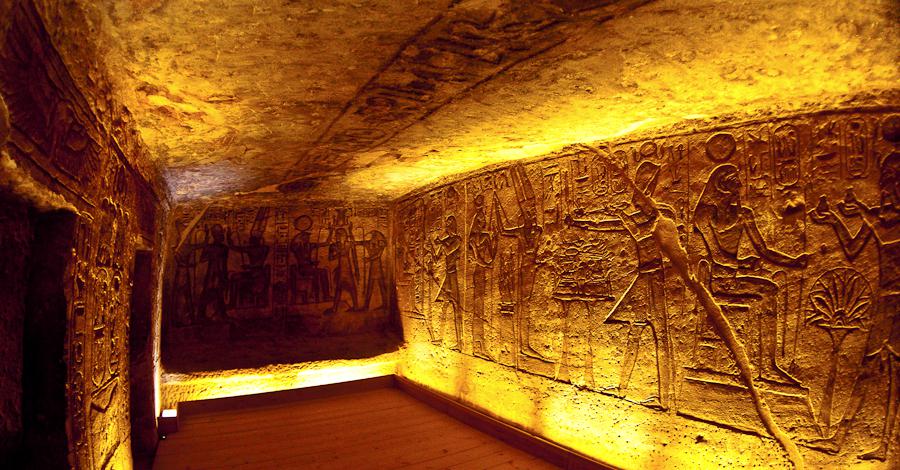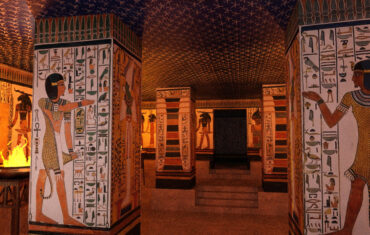The story of Abu Simbel
The Temple of Abu Simbel, built by pharaoh Ramses II, is one of the symbols of Egypt and of the whole of antiquity along with the Pyramids and the Sphinx of Giza. It is near the southern border of the Country, carved and built in 1260, d.C.. The temple is encased in a gigantic wall of rock. On march 22, 1813, after centuries of abandonment, the temple of Abu Simbel was rediscovered by the scholar of the swiss Johann Ludwig Burckhardt. Burckhardt scopì, in the past, the ancient city of Petra in Jordan. Passed 4 other years in which the site remained untouched until, in 1817, the Italian Giovanni Battista Belzoni, after months of work, he managed to find the way to enter the huge complex.
So it was the first man that entered into the temple, at a distance of thousands of years. Passed other decades until, in 1909, it was revealed the temple and shown in all its majesty. Despite its troubled history, the charm of the temple of Abu Simbel has remained intact. In fact, in 1979, was inserted by Unesco in the list of world heritage sites.
The Great temple of Abu Simbel
The Abu Simbel complex includes the Great and Small temples, built on the orders of Ramses II after the victory over the Hittites at Kadesh in 1296 BC. this battle was considered by the Pharaoh to be the main act of his life and ordered to perpetuate the memory of it in many of his buildings throughout Egypt. The great monument is located in Nubia, South of Aswan, almost on the border of Egypt and Sudan.
The height of the mountain is approximately 100 meters, the rock temple is carved into a sand hill, and it seems that it has always been there. The monuments are so exquisitely carved out of stone that they are rightfully called the pearl of Egyptian architecture. Details of the four gods guarding the entrance to the temple are clearly visible even at a considerable distance, while they feel massive and Grand.
The transfer of the temples
In the 60s of the XX century, the masterpieces of architects and builders of Ancient Egypt were threatened with destruction by their distant descendants. On the Nile, the construction of the Aswan hydroelectric power station began, and the temples fell into the flood zone. Many proposals were put forward to preserve the monuments of ancient architecture, including the construction of an underwater dome over the temples.
Of all the projects, perhaps the most improbable was chosen, but it also turned out to be correct. It was decided to take the buildings apart and move them to the new Bank of the Nile. The project was implemented by specialists from 50 countries around the world. For four years, the temples were sawn into 1036 blocks weighing up to 30 tons, which were transported to the site of future installation 65 meters upstream and 200 meters further from the shore. There the blocks were drilled and filled with a viscous mixture to increase the strength of the stone.

After the preparatory operations were completed, the stone fragments were reassembled in full accordance with their original location. The temples were recreated to the smallest detail. Even the broken head of one of the colossi lies in relation to its “host” as before the transfer. The buildings are covered with a reinforced concrete dome, filled with fragments of rocks, and it seems that the temples have always stood here.
The temple relocation operation gave an opportunity to study the construction technologies of the Egyptians. As it turned out, the facades of the temples were located exactly along the cracks in the rock base, which gave the buildings stability. This testifies to the deep knowledge of the ancient Egyptian architects.
The relocation of Abu Simbel’s temples, completed in 1968, was one of the greatest engineering operations of the century. The works cost $ 42 million (now it is about $ 1.5 billion).
However, looking at the colossi of Abu Simbel sitting calmly at the entrance to the temple, you begin to understand that preserving the memory of humanity is worth any effort and money spent.
The Great temple dedicated to the Pharaoh Ramses II and the three gods: Amon, RA-Horakhta and Ptah.
The great temple was carved out of a solid rock face. At the entrance, made in the form of a classical pylon, four statues with a height of more than 20 meters are cut out. This is depicted seated gods Amun, RA-Horakhty, Ptah and the Pharaoh himself. Ramses II considered these gods his protectors. Their names were even given to the army corps that operated at Kadesh.
The gods and the Pharaoh are depicted in Royal robes, with the double crowns of Egypt. All four statues bear a portrait resemblance to Ramses II. At the same time, the similarity is striking, as evidenced by numerous sculptures of the Pharaoh, which are much more carefully finished and much smaller. In General, the accuracy of all the proportions of the monuments is surprising, given their scale.
At the feet of Ramses II are placed statues of members of his family-his mother, wife Nefertari and several children, who were not less than two hundred in total. The height of the facade of the temple exceeds 30 meters.
The huge statues of Ramses II were visible from afar to all who were sailing on the Nile. And when the first rays of the sun appeared on the horizon, the colossi turned dark red, standing out sharply against the blue-black shadows they cast.
The temple consists of 4 successively smaller halls and a number of side rooms. The first hall is framed by four-sided columns, in it there are statues of Ramses II, depicted with the attributes of Osiris. Anyone could enter. The second hall was reserved only for the noble class, the third was open only to the clergy, and the fourth was open only to the Pharaoh himself with his family and entourage.
The walls of the halls are covered with frescoes and reliefs depicting the deeds of the Pharaoh, as well as sacred texts. On the ceilings are images of the sun, which represented the king’s power, and the Cobra, a symbol of justice and the inevitability of punishment for wrongdoing.
How to get to Abu Simbel
Abu Simbel is located 280 Km south of Aswan, 40 Km north of the sudanese border, on the western bank of Lake Nasser. Apart from the nearby Nile river, the environment around is totally desert. Both the Temple of Abu Simbel and that of Nefertari, are carved into the living rock of a hill of sandstone. To get to Abu Simbel starting drive from Aswan, which takes around 4 hours going through nearly 300 km of desert.
It is advisable to reach the site by taking the flights from Aswan: including travel, the visit lasts about 5 hours including the nearby Temple of Nefertari, wife of Ramses II, and of the Goddess Hator. You can get to Abu Simbel through the navigation on Lake Nasser as a real cruise. Because of the dam, however, it is not possible to continue directly on the river but you have to make a transfer and take another ship.



